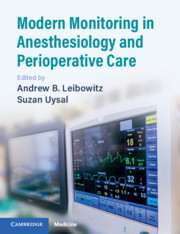Book contents
- Modern Monitoring in Anesthesiology and Perioperative Care
- Modern Monitoring in Anesthesiology and Perioperative Care
- Copyright page
- Contents
- Contributors
- Preface
- Chapter 1 Statistics Used to Assess Monitors and Monitoring Applications
- Chapter 2 Multimodal Neurological Monitoring
- Chapter 3 Cerebral Oximetry
- Chapter 4 The Oxygen Reserve Index
- Chapter 5 Point-of-Care Transesophageal Echocardiography
- Chapter 6 Point-of-Care Transthoracic Echocardiography
- Chapter 7 Point-of-Care Lung Ultrasound
- Chapter 8 Point-of-Care Ultrasound: Determination of Fluid Responsiveness
- Chapter 9 Point-of-Care Abdominal Ultrasound
- Chapter 10 Noninvasive Measurement of Cardiac Output
- Chapter 11 Assessing Intravascular Volume Status and Fluid Responsiveness: A Non-Ultrasound Approach
- Chapter 12 Assessment of Extravascular Lung Water
- Chapter 13 Point-of-Care Hematology
- Chapter 14 Assessment of Intraoperative Blood Loss
- Chapter 15 Respiratory Monitoring in Low-Intensity Settings
- Chapter 16 The Electronic Health Record as a Monitor for Performance Improvement
- Chapter 17 Future Monitoring Technologies: Wireless, Wearable, and Nano
- Chapter 18 Downside and Risks of Digital Distractions
- Index
- Plate Section (PDF Only)
- References
Chapter 2 - Multimodal Neurological Monitoring
Published online by Cambridge University Press: 28 April 2020
- Modern Monitoring in Anesthesiology and Perioperative Care
- Modern Monitoring in Anesthesiology and Perioperative Care
- Copyright page
- Contents
- Contributors
- Preface
- Chapter 1 Statistics Used to Assess Monitors and Monitoring Applications
- Chapter 2 Multimodal Neurological Monitoring
- Chapter 3 Cerebral Oximetry
- Chapter 4 The Oxygen Reserve Index
- Chapter 5 Point-of-Care Transesophageal Echocardiography
- Chapter 6 Point-of-Care Transthoracic Echocardiography
- Chapter 7 Point-of-Care Lung Ultrasound
- Chapter 8 Point-of-Care Ultrasound: Determination of Fluid Responsiveness
- Chapter 9 Point-of-Care Abdominal Ultrasound
- Chapter 10 Noninvasive Measurement of Cardiac Output
- Chapter 11 Assessing Intravascular Volume Status and Fluid Responsiveness: A Non-Ultrasound Approach
- Chapter 12 Assessment of Extravascular Lung Water
- Chapter 13 Point-of-Care Hematology
- Chapter 14 Assessment of Intraoperative Blood Loss
- Chapter 15 Respiratory Monitoring in Low-Intensity Settings
- Chapter 16 The Electronic Health Record as a Monitor for Performance Improvement
- Chapter 17 Future Monitoring Technologies: Wireless, Wearable, and Nano
- Chapter 18 Downside and Risks of Digital Distractions
- Index
- Plate Section (PDF Only)
- References
Summary
In this chapter the basic principles of neuromonitoring will be reviewed. Evidence-based applications, advantages, and disadvantages of various invasive and noninvasive techniques for monitoring intracranial pressure, brain tissue oxygenation, cerebral blood flow, brain metabolism, electroencephalography, and evoked potentials will be covered.
Keywords
- Type
- Chapter
- Information
- Publisher: Cambridge University PressPrint publication year: 2020

